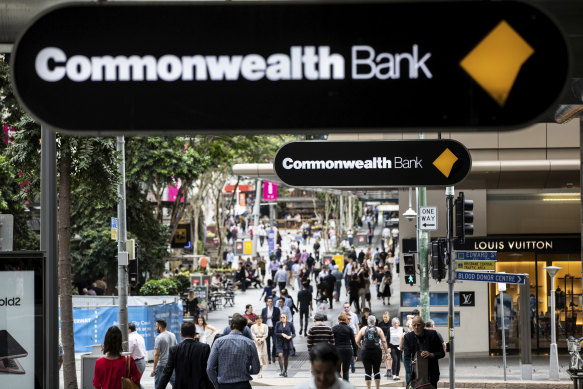This was published 1 year ago
Investors wary on CBA margins after record $10.2b profit
By Millie Muroi
Investors say Commonwealth Bank’s margins will be squeezed by stiff competition in mortgages and customers moving their cash to higher interest savings accounts, after the bank delivered record earnings and unveiled a surprise $1 billion share buyback.
As markets focus on how a wave of refinancing is affecting Australian banks’ returns from mortgages, CBA chief executive Matt Comyn on Wednesday said he expected the market for home loans and deposits would remain highly competitive, and that late repayments would increase.
“There are signs of downside risks building as rising interest rates have a lagged impact on mortgage customers and other cost of living pressures become a financial strain for more Australians,” he said.
“We are seeing consumer demand moderate and economic growth slow, and we are closely monitoring the impact of reduced discretionary spend, particularly on our small and medium-sized business customers.”
On Wednesday, CBA reported a 6 per cent increase in its cash profits to $10.2 billion, surpassing its previous record of $9.9 billion in 2017. The bank’s earnings were broadly in line with the consensus forecast among analysts.
It also announced it would pay a final dividend of $2.40 a share, taking the total dividend for the year to $4.50 a share, up 17 per cent from the previous year.
Shares in CBA closed 2.7 per cent higher at $104.98 a share.
Morningstar analyst Nathan Zaia said the bank’s net interest margin – what it charges for loans compared with funding costs – was a key contribution to the CBA’s profits, but that it would likely soften.
“There’s still a few things that’ll be a drag,” he said. “These include funding cost pressures from wholesale funding, more customers switching into those online savings and term deposits, and a lot of continued refinancing.”
CBA’s net interest margin increased 17 basis points over the year to 2.07 per cent, but decreased 5 basis points from the first half, with Comyn saying it peaked in late 2022.

CBA will pay a final dividend of $2.40 a share, taking the total dividend for the year to $4.50 a share.Credit: Attila Csaszar
Comyn confirmed that increased competition in home lending partly offset the boon from a rising interest rate environment.
“It will continue to be a very competitive context for home lending certainly in the foreseeable future,” he said.
Moody’s Investors Service vice president Daniel Yu said he expected earnings pressures to emerge for CBA in 2024 and that competition was likely to limit further margin gains.
“Meanwhile, inflationary pressures will make cost management difficult and the operating environment is also likely to weaken, leading to even higher credit impairment charges,” he said.
Australian Eagle Asset Management chief investment officer Sean Sequeira said there had been an uptick in signs that customers were facing pressure in paying back loans, but that CBA’s provisions for bad debt didn’t rise as much as expected.
Although currently at a historically low level, Comyn said consumer arrears had increased in recent months, and he expected the number of people behind on loan repayments to continue to rise over the course of the year as they felt the full effects of previously announced cash rate increases.
Sequeira said the $1 billion buyback suggested the bank was in good shape but that it also implied the bank’s loan growth “may not be that large” going forward.
“When loans are growing very strongly, banks tend to hold on to capital to be able to manage the capital requirements of secure loan growth,” he said.

Commonwealth Bank chief executive Matt Comyn says signs of downside risk are building.
CBA’s household deposits increased by $18.3 billion over the year, but at a slower pace than the banking system more widely – particularly in the first half. Comyn said he anticipated a very competitive environment in the year ahead for household deposits.
Commonwealth Bank grew its business lending portfolio, adding $14.5 billion or 11.4 per cent.
Comyn said the drivers of business lending were varied but that healthcare, agriculture and parts of hospitality and industrial commercial property were the main areas driving business loan growth.
Meanwhile, Comyn said troublesome and impaired assets had increased, primarily driven by increases in the construction and commercial property sectors. “Obviously, there’s been a lot of pressure on construction and particularly in housing construction,” Comyn said.
“But we’ve actually seen the fourth quarter a bit better than the third quarter, so we think that we’ve been through the worst of it in construction. In terms of commercial property ... there will continue to be pressure on valuations in lower grade, commercial property.”
CBA’s provisions for loan impairments increased from $5.3 billion to $6 billion this financial year, which the group said reflected the impact of cost of living pressures and rising interest rates on consumer and corporate portfolios.
The Business Briefing newsletter delivers major stories, exclusive coverage and expert opinion. Sign up to get it every weekday morning.